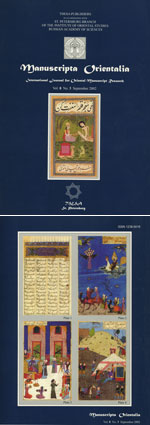|
|
| |

|

|
Jakobson V., Lezin G. Computer Analysis of the Laws of Hammurabi: Basic Concepts // Manuscripta Orientalia. Vol. 8, No 3, September 2002. P. 59-65.
Introduction
We indicate with the term “computer analysis” a fairly specialized form of analysis based on formal logic and modelling of the text under investigation. The model of the text is a formal description of its contents. It is constructed by a researcher or, in our case, a historian. The object of modelling a selected body of texts on the basis of the concepts they advance and their internal conceptual hierarchy is to establish a formal system of information about a concrete historical period or phenomenon. We are thus able to use the computer to systematize and analyse what we learn through our research. One of the most important results of such analysis is a body of information that reflects this knowledge and can subsequently be analysed automatically and used. One example of such use is searching and selection on the basis of a logical conclusion drawn from what we know. In our case, the laws of Hammurabi and accompanying documents have been chosen for analysis.
The Laws of Hammurabi (Code of Hammurabi) is the accepted scholarly name for the most important and largest legal text from ancient Mesopotamia. The text was drawn up in Akkadian (now a dead language) in the eighteenth century B.C. and later written in cuneiform on stone stelas set up in Babylon and other important Mesopotamian cities. The text of the Laws circulated until the very end of “cuneiform” culture in the form of copies on clay tablets. The only stone stela with the text of the Laws to have come down to us was discovered by archaeologists at the beginning of the twentieth century in South West Iran, home to the ancient state of Elam. The Elamites brought it there as a war trophy after one of their raids on Babylonia several centuries after the Laws were made public. The Elamites carved off a part of the text on the stela, most likely intending to carve in its place a triumphal inscription, but for some reason did not complete their task. The resultant lacuna in the text has only been partially filled on the basis of clay-tablet copies, as all copies are to some degree partial or defective.
The first scholarly publications on the Laws of Hammurabi, translations into modern languages and more or less extensive commentary appeared soon after the Laws were discovered. New publications continue to appear as new fragments of the text are discovered, our knowledge of the Akkadian language improves, and progress is made in the interpretation of the text. One should note that the first publisher divided the text into three sections: Prologue, Laws, and Epilogue. The Prologue and Epilogue contain the religious basis for Hammurabi’s power, his rights and obligations as lawgiver and keeper of Truth and Justice (the two concepts were personified as deities), explain the reason for promulgating the Laws and bestow blessings on future rulers who will observe them and curses on those who would break them. They are written in high style, intentionally archaic even for the time of their composition. They b e-long to the genre of prose literature. At the present stage of our work, these two sections are not amenable to formal analysis. But the text of the laws is written in dry, precise, strictly formalized language; it forms a perfect subject for our purposes, although some circumstances complicate our task.
The goal of the present work is to demonstrate with a few examples certain basic principles of using formal logic in text analysis, its possibilities and difficulties. Subsequent instalments will examine the particular features of the documents analysed, treat the basic elements and characteristics of the formal language used to define textual models, and provide examples of models.
We relied on the MAZE database administration system, which allows for the collection of texts, their formal description, indexing, conceptual dictionaries, and a network of associative links between texts to produce a hypertext and reveal the conceptual dimension of this hypertext. The system allows for the entry and processing of three types of information:
— texts and their formal description in textual form;
— conceptual information drawn by the system from the descriptions of texts or set by the researcher;
— dictionaries and indices to the texts.
Texts are built up in a card-catalogue system. Along with traditional subject headings and hypertexts, the card catalogue allows one to construct and process card networks linked by preset binary relations. This gives the researcher a chance to determine the associative links between the texts. Practice shows the usefulness of these methods; for example, in carrying out various types of se-miotic research.
 PDF-files PDF-files
The entire paper
Keywords
The Laws of Hammurabi
Manuscripta Orientalia, selected papers
|
|
|
|
Random news: Announcements |
|
An extended meeting of the Academic Council will be held at 14:00 on Wednesday, May 15, 2024. Six talks will be given on the topic of “Oriental studies: teachers and students”. |
|
Read more...
|
|
|
|
|

